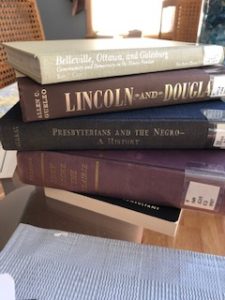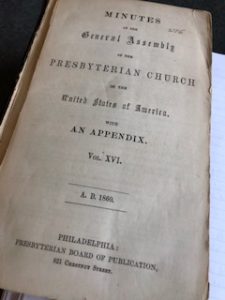In my last post I discussed the plan I was making for the second Sweet Iron mystery. Because I have no imagination when it comes to titles, we are calling it Book #2. Eventually, the spirit will move me, and I’ll have a title. Since I’m going back in time with this book, it’s important that I do more research than I did for A Death at Tippitt Pond, which gently explored the history I had lived through in the 1960s and 1970s. In this post I’ll explain a very small percentage of the research digging for Book #2. Research will be on my agenda for the next month or two. As I read, my mind is stimulated, both awake and asleep, to come up with characters who will fit into this period of time.
Having looked through some genealogy books and general encyclopedias of daily life in the United States up to 1861, I am  now ready to find out the answers to some more pressing questions. 1850-1860 seems like a good decade to start with, and I haven’t decided yet what I’m going to do with the Civil War. At this point I believe I may stop short of that war. Some of the specific dates of events in that decade, as well as some answers about starting towns in the Midwest will be good areas to research. While my little town of Sweet Iron is not the same as my home town of Galesburg, I believe some of the same realities might apply to their beginnings.
now ready to find out the answers to some more pressing questions. 1850-1860 seems like a good decade to start with, and I haven’t decided yet what I’m going to do with the Civil War. At this point I believe I may stop short of that war. Some of the specific dates of events in that decade, as well as some answers about starting towns in the Midwest will be good areas to research. While my little town of Sweet Iron is not the same as my home town of Galesburg, I believe some of the same realities might apply to their beginnings.
Very basic events [remember, history is only the context for a mystery] leading up to the war can be found in numerous places. I decided to look at an online website called The American Battlefield Trust, run by the National Park Service. It ticks off dates and events leading up to the war, including the firing on Fort Sumter, the election of Lincoln, the secession of several Southern states in 1860, the forming of the Confederate States of America, and the secession of still more states in 1861. My characters in Book #2 would know about these events both from newspapers, and eventually, the telegraph. Since Webb Tippitt is the owner and editor of the local newspaper, he will receive the news as part of his job.
One of the characters in Book #2 is going to be a Presbyterian minister. Both Galesburg and Monmouth–my current town–are communities begun by Presbyterians planning to start new religious communities with colleges. This Presbyterian minister, as yet unnamed, is also an ardent abolitionist. He, along with a local doctor and trustees of the college (one of whom is a farmer), are also friends with Webb Tippitt. So it’s important that I learn a bit about each of these fictional characters, write a backstory for each of them, and consider what parts they will play in this story of Beth Russell’s ancestors.
 For that reason, I discovered Hewes Library–at Monmouth College–has all the minutes of the Presbyterian Church’s Assembly, a meeting each year of representatives from all the synods of the church from every part of the country. I read the minutes of each year from 1860-1865 to see what happened in the church as war became part of the lives of these characters. While the church fathers first discussed secession and whether it was a religious, moral, or political issue, I could clearly see the divide between the North and South. In 1860, the Southern synods were all present at the meeting. After that, they were gone, and the minutes of the war years became more and more militant with discussions of the immorality of slavery. Now I need to go back and look at those minutes between 1850 and 1860, the years I’m contemplating for the second plot in Book #2.
For that reason, I discovered Hewes Library–at Monmouth College–has all the minutes of the Presbyterian Church’s Assembly, a meeting each year of representatives from all the synods of the church from every part of the country. I read the minutes of each year from 1860-1865 to see what happened in the church as war became part of the lives of these characters. While the church fathers first discussed secession and whether it was a religious, moral, or political issue, I could clearly see the divide between the North and South. In 1860, the Southern synods were all present at the meeting. After that, they were gone, and the minutes of the war years became more and more militant with discussions of the immorality of slavery. Now I need to go back and look at those minutes between 1850 and 1860, the years I’m contemplating for the second plot in Book #2.
I am also considering whether the characters might have gone to the Lincoln-Douglas debate in Galesburg on October 9, 1858. I found newspaper descriptions of the debate–the original newspapers–and also an entire book dedicated to that event. I obviously don’t need an entire book, but if I decide to send Beth’s ancestors to that debate, I’ll need to have an accurate account of what they heard. Yes, I remember my editor saying, “the mystery is important–don’t include too much history to muddy the waters.”

Every half hour or so, I stop my research and take a walk through the stacks…
Finally, I borrowed a copy of They Broke the Prairie by Earnest Elmo Calkins, written in 1937. This book is a wonderful source of information. It answers my questions about how the town of Sweet Iron might have begun. It describes the founding of Galesburg and Knox College from the earliest planning stages by Rev. George Washington Gale in New York. I remembered many details of the Northwest Territory and how it was divided. But Calkins did a clear, concise job of explaining the first ten years before the settlers even had much in the way of stores or buildings in Galesburg, to the second decade, the one I particularly need to know. He also explains clearly the contrasting settlement patterns between the northern Illinois settlers, who were wealthier and more of a business class, and the southern Illinois settlers, who were poor whites who came mainly from Southern states. The battle over slavery was already drawing sides from the very early settlement of the state. Slavery existed in much of southern Illinois even though the charter for the territory strictly forbade it. Neither part of the state trusted the other, so this is a great help in providing a conflict in my book. If WW Tippitt provides a safe house for runaway slaves, who is likely to come after those slaves?
Even in this early research, the battle lines are drawn. This is only one plot I’m researching. I will need to combine it with a modern-day plot involving Beth Russell and her Sweet Iron friends in the present day. Already a plot is forming in my head for the ancestors of Beth Russell. We’ll see how the history will layer in an interesting context for the characters I’m envisioning.
After thinking, thinking, thinking, I am now in the research stage, and I still have many questions to answer about this early plot. The second plot in the present day is on my mind also. I always know when I’m making progress because my sleep is interrupted with plot turns and character names. If only I could dream about titles.

Love this! I also love research, but you are in a class by yourself. The crazy thing is likely only 15% will end up in the book!
Oh, Judy, I understand. But since I headed off into the Tippitt Pond mysteries, I also changed course. Beth Russell, my protagonist, is, as you know, a historical researcher and genealogist. So it seems quite evident that I have to fall back on my history mania. You research plenty yourself, and you are right that only a small part ends up in the book! Thanks for dropping by.
Yes, by all means, Beth’s “people” must attend the Lincoln-Douglas Debate held in Galesburg, the location of the only original debate site still standing–Old Main.
I have yet to read the first “Tippett” mystery (deep into writing my 2nd novel). But will do so soon and write a review. Susan, based on your previous mysteries, it is certain to be a first-rate whodunit.
Thanks, Jim. I’m thinking about the debate, but it will have to be part of the mystery. I think I can do that. Waiting for your second book!